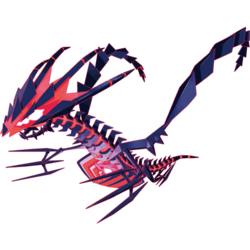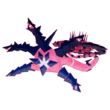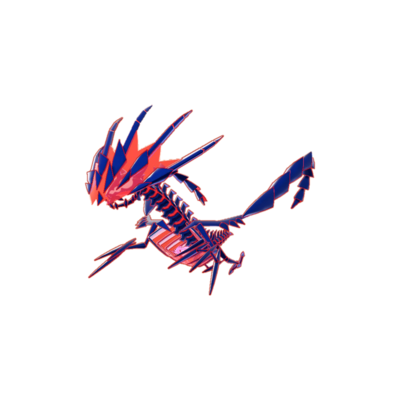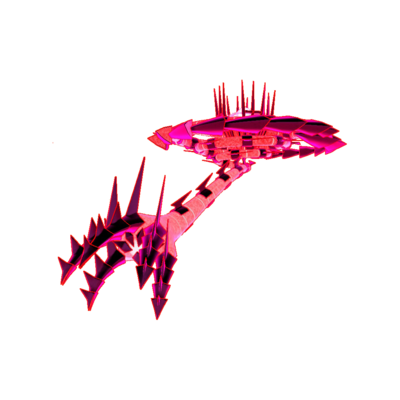Eternatus (Japanese: ムゲンダイナ Mugendina) is a dual-type Poison/Dragon Legendary Pokémon introduced in Generation VIII.
While it is not known to evolve into or from any other Pokémon, the player battles a powered-up form of Eternatus known as Eternamax Eternatus in the climax of Pokémon Sword and Shield. Prior to Generation IX, this form was also briefly seen when it uses its signature move, Eternabeam, but it cannot be acquired legitimately in-game.
Biology
Eternatus is a gigantic, draconic alien Pokémon. Its body has a vaguely draconic shape and a skeletal appearance, and is largely dark violet with red highlights. Its main body and tail are long, thin, and resemble a spinal column, and it has four small, thin limbs ending in claws formed from spindly appendages attached at right angles. Its torso is formed from a cage of appendages resembling ribs, and inside is a glowing pink core that serves as Eternatus's energy source, absorbing energy to sustain it. The core can also project its absorbed energy into massive blasts when using Dynamax Cannon, one of its signature moves. Its head is triangular in shape and has a pair of white, eye-like markings in the form of three connected circles, as well as a spindly lower jaw with several diamond-shaped teeth. Over its head is a translucent red film held between five long spikes extending toward its body's rear. It also has a pair of thin tendrils extending from its back, formed from numerous triangular segments. Eternatus's gigantic size makes it the tallest known Pokémon to ever exist.
If Eternatus absorbs a massive amount of energy at once, it will enter its Eternamax form, which is said to be its true appearance and is far larger in size. Eternatus will also briefly enter this form when using Eternabeam, another one of its signature moves. In this form, Eternatus's shape drastically changes. Its body becomes incredibly long and serpentine with most of its body forming a massive coil. Its entire body glows red in this form, and present at regular intervals across its length are black rings with spikes extending outward. Its back tendrils now curl around its main body. Its energy core rests at the center of the coil inside a cage of violet spikes. Eternatus's head takes on the form of a giant hand, with its fingers covered in black armor with spikes extending from the back of each segment. At the tip of each finger is a glowing pink eye.
Eternatus serves as the source of the Dynamax and Gigantamax phenomena in Galar due to its power leaking out in the form of Galar Particles following its defeat thousands of years ago by Zacian and Zamazenta. Pieces of its body imbued with its power rain down throughout Galar in the form of Wishing Pieces and Wishing Stars. When it is awake, Eternatus causes a phenomenon dubbed the Darkest Day, in which the massive quantities of Dynamax energy it unleashes causes Pokémon to Dynamax and rampage uncontrollably. It can also sometimes keep other Pokémon from Dynamaxing in its presence. Despite this connection to the phenomenon, it cannot be Dynamaxed itself, as its Eternamax form replaces that effect. Eternatus has been referred to as the Darkest Day.
As seen in the anime, Eternatus can use its energy core to target a Pokémon and force it to Dynamax or Gigantamax. The anime also elaborates upon its ability to block other Pokémon from Dynamaxing, depicting this power as Eternatus absorbing the Galar Particles in the area to make them unavailable for other Pokémon to use. It is also shown to be capable of forcibly reverting other Pokémon that have already Dynamaxed or Gigantamaxed through the same process. According to Rose in the anime, he was the one to have coined Eternatus’s name.
In its Eternamax form, Eternatus's power grows so immense that it causes a great storm of Dynamax energy around it, ripping holes in spacetime in the midst of the storm as it releases a virtually infinite amount of energy. Its tremendous power can even prevent opposing Pokémon from attacking it as it gathers energy.
Eternatus is an extraterrestrial Pokémon that came to Earth inside a meteor around 20,000 years ago.
Eternatus is the only known Pokémon capable of learning the moves Dynamax Cannon and Eternabeam. In Generation IX, Cross Poison is also one of its signature moves.
In the anime
Main series

Eternamax Eternatus in the anime
Major appearances
Eternatus debuted in Flash of the Titans!, where it passed by the Galar-bound plane that Ash and Goh boarded, causing interference to it in the process.
In Sword and Shield: "From Here to Eternatus!", Eternatus emerged from the Energy Plant reactor, where it had been placed by Macro Cosmos, and began wreaking havoc as it started the Darkest Day. In Sword and Shield... The Legends Awaken!, it entered its Eternamax form after Leon's failed attempt at catching it. Ash and Goh proceeded to battle it with their Pokémon, along with Zacian and Zamazenta. They eventually managed to defeat Eternatus, who ended up getting caught by Goh and sealed away deep underground by Professor Magnolia. He later gave it to Leon. After Eternatus senses the intense energy created by Ash and Leon's battle and stabilizes Galar particles, it returns to the wild.
Minor appearances
Pokémon Evolutions

Eternamax Eternatus in Pokémon Evolutions
Eternatus appeared in a flashback in The Champion, where it was battled against by Victor and Hop during the Darkest Day and subsequently caught by the former.
In the manga
Pokémon Adventures
Eternatus debuted in PASS25. It later entered its Eternamax form.
Pokémon Journeys: The Series
- Main article: Leon's Eternatus
Eternatus debuted in Flash of the Titans!. It reappeared in Sword and Shield... The Legends Awaken! (Part 2), where it was caught by Goh, just like in the anime.
In the TCG
- Main article: Eternatus (TCG)
Game data
Pokédex entries
| This Pokémon was unavailable prior to Generation VIII.
|
| Generation VIII
|
|
Galar
#400
|
|
Sinnoh
#—
|
|
Hisui
#—
|
| This Pokémon has no Pokédex entries in Brilliant Diamond, Shining Pearl, and Legends: Arceus.
|
| Sword
|
The core on its chest absorbs energy emanating from the lands of the Galar region. This energy is what allows Eternatus to stay active.
|
| Shield
|
It was inside a meteorite that fell 20,000 years ago. There seems to be a connection between this Pokémon and the Dynamax phenomenon.
|
| Eternamax Eternatus
|
| Sword
|
As a result of Rose's meddling, Eternatus absorbed all the energy in the Galar region. It's now in a state of power overload.
|
| Shield
|
Infinite amounts of energy pour from this Pokémon's enlarged core, warping the surrounding space-time.
|
|
|
|
|
Game locations
| This Pokémon was unavailable prior to Generation VIII.
|
|
|
|
|
In side games
| This Pokémon was unavailable prior to Generation VIII.
|
|
|
In events
Stats
Base stats
Eternatus
| Stat
|
Range
|
| At Lv. 50
|
At Lv. 100
|
140
|
|
200 - 247
|
390 - 484
|
85
|
|
81 - 150
|
157 - 295
|
95
|
|
90 - 161
|
175 - 317
|
145
|
|
135 - 216
|
265 - 427
|
95
|
|
90 - 161
|
175 - 317
|
130
|
|
121 - 200
|
238 - 394
|
Total: 690
|
Other Pokémon with this total
|
- Minimum stats are calculated with 0 EVs, IVs of 0, and (if applicable) a hindering nature.
- Maximum stats are calculated with 252 EVs, IVs of 31, and (if applicable) a helpful nature.
|
Eternamax Eternatus
| Stat
|
Range
|
| At Lv. 50
|
At Lv. 100
|
255
|
|
315 - 362
|
620 - 714
|
115
|
|
108 - 183
|
211 - 361
|
250
|
|
229 - 332
|
454 - 658
|
125
|
|
117 - 194
|
229 - 383
|
250
|
|
229 - 332
|
454 - 658
|
130
|
|
121 - 200
|
238 - 394
|
Total: 1125
|
Other Pokémon with this total
|
- Minimum stats are calculated with 0 EVs, IVs of 0, and (if applicable) a hindering nature.
- Maximum stats are calculated with 252 EVs, IVs of 31, and (if applicable) a helpful nature.
|
Type effectiveness
| Under normal battle conditions in Generation IX, this Pokémon is:
|
|
|
|
|
|
|
|
|
|
|
|
|
Learnset
|
|
|
|
- Bold indicates a move that gets STAB when used by Eternatus
- Italic indicates a move that gets STAB only when used by an Evolution of Eternatus
|
|
|
|
|
- Bold indicates a move that gets STAB when used by Eternatus
- Italic indicates a move that gets STAB only when used by an Evolution or an alternate form of Eternatus
|
|
|
|
|
- Moves marked with an asterisk (*) must be chain bred onto Eternatus
- Bold indicates a move that gets STAB when used by Eternatus
- Italic indicates a move that gets STAB only when used by an Evolution of Eternatus
|
Side game data
Eternatus
Eternamax Eternatus
Evolution
Forms
Sprites
| This Pokémon was unavailable prior to Generation VIII.
|
|
|
Trivia
- Eternatus is the only Pokémon with a base stat total of 690.
- Eternatus, in both of its forms, is the tallest Pokémon.
- Eternatus is the heaviest Poison-type and Dragon-type Pokémon, and also the heaviest Pokémon overall introduced in Generation VIII.
- Eternatus is the only Poison-type Legendary Pokémon, excluding Silvally holding a Poison Memory.
- Eternatus, Zacian, and Zamazenta are the only Pokémon available in Pokémon Sword and Shield that cannot Dynamax.
- Pokémon transformed into Zacian, Zamazenta, or Eternatus will also be unable to Dynamax.
- Despite this, Eternatus is still capable of using Max Moves in its Eternamax form. This makes it the only non-Dynamax Pokémon that can use Max Moves.
- If the player has no Poké Balls when they are prompted to capture Eternatus, one will appear in their bag.[1]
- If the player has no storage space, an extra box will be unlocked to make room for Eternatus. [1]
- Eternatus is the first Legendary Pokémon that can be caught with any Poké Ball without the chance of failing.
- Eternamax Eternatus:
- Has the highest base HP stat of all Poison-type and Dragon-type Pokémon.
- Is tied with Blissey for the highest base HP stat of all Pokémon.
- Has the highest base Defense and Special Defense stats of all Pokémon.
- A level 100 Eternamax Eternatus could reach 655 in one of these stats, which would cause the stat to overflow to 0, due to a quirk in the coding for Pokémon Sword and Shield which affects no other Pokémon.
- Has the highest base stat total of all Pokémon, with 1125.
- This also makes it the only Pokémon with a four-digit base stat total.
- Eternatus and Regigigas have very similar category names in Japanese, with the only difference being in how they're written: Regigigas's category name is in hiragana (きょだいポケモン), while Eternatus's category name is in katakana (キョダイポケモン). In either case, the category name is pronounced the same: Kyodai Pokémon.
- Unlike other Pokémon in the anime, Eternatus is animated with 3D animation rather than 2D during the Sword and Shield arc. Currently, it is the only Pokémon to have done so.
- Eternatus is the first Pokémon animated with either 2D or 3D animations outside of movies.
- In the anime, Chairman Rose is the one who named Eternatus. It had previously shared its name with the Darkest Day event.
- Eternatus is the first Legendary Pokémon caught by a main character or Champion in the anime.
- In Pokémon UNITE, if the language is set to Russian, Eternatus is referred to as both Итернатус Iternatus and Этернатус Eternatus, while Pokémon GO and the Pokémon Trading Card Game Online only use the latter spelling.
- While using Eternabeam, Eternatus is displayed in its Eternamax form for the duration of the move's animation. This is the only time Eternamax Eternatus is seen outside of the battle against Eternatus during the climax of Pokémon Sword and Shield's story.
- Strangely, the game does not treat this as a form change internally, Eternatus's stats and form index value remain unchanged. Furthermore, if Shiny Eternatus uses the move, the Shiny version of its Eternamax form is not registered in the player's Pokédex.
- However, a shiny Eternamax Eternatus can be registered in Pokemon HOME's Pokédex by depositing Shiny Eternatus into HOME's storage, as it automatically registers both forms.
Origin
Eternatus's extraterrestrial nature and dragon-like appearance may be inspired by Uther Pendragon, King Arthur's father, who acquired his epithet and started using dragons on his standards after witnessing a dragon-shaped comet. Its abilities may also draw inspiration from nuclear power, particularly its seemingly endless supply of energy which Rose attempted to use as a power source for Galar and which leaks out in the form of particles and is the source of the Dynamax phenomenon. In fiction, nuclear radiation is often used as a catalyst for granting superpowers or creating kaiju, most famously Godzilla.
Its overall body shape resembles the skeletal remains of a European dragon, with the ribcage shaped like a cannon and the head resembling that of the common nawab or "dragonhead" caterpillar.
Eternamax Eternatus resembles a hand crossed with a serpent. It may be based on the Lernaean Hydra, a multi-headed serpentine monster from Greek mythology, known for its poisonous breath and blood, with Eternatus' "fingers" representing the Hydra's heads. It may also be based on the biblical Seven Headed Dragon that, in the Book of Revelation, throws one-third of all stars down to the Earth and is ultimately banished to Earth with the Nephilim, the Hebrew giants — an event that ultimately leads to the end of time. This account may also be the origin of the item Wishing Star and the Darkest Day. It may also be inspired by Ananta Shesha, the king of Nagas in Hindu mythology who is usually portrayed as a giant, coiled serpent with a thousand heads capable of spewing venom and fire, though some depictions simplify his appearance down to five heads, again reflected in Eternatus' five "fingers". Shesha bears the deity Vishnu on its coils, similar to how Eternamax Eternatus's core is mounted atop its coiled body.
Name origin
Eternatus may be derived from aether, eternal, aeternatus (Latin for immortalized), and Thanatus (Latin transliteration of Thanatos, the personification of death in Greek Mythology).
Mugendina may be a combination of 無限大 mugendai (infinity), ダイマックス Daimax (Dynamax) and possibly dynamic.
In other languages
| Language
|
Title
|
Meaning
|
 Japanese Japanese
|
ムゲンダイナ Mugendina
|
From 無限大 mugendai, ダイマックス Daimax, and possibly dynamic
|
 French French
|
Éthernatos
|
From éternel, éther, and Thanatos
|
 Spanish Spanish
|
Eternatus
|
Same as English name
|
 German German
|
Endynalos
|
From endlos or Ende and Dynamax
|
 Italian Italian
|
Eternatus
|
Same as English name
|
 Korean Korean
|
무한다이노 Muhandaino
|
From 무한 (無限) muhan, 다이맥스 Daimax, and dino
|
 Mandarin Chinese Mandarin Chinese
|
無極汰那 / 无极汰那 Wújítàinà
|
From 無極 / 无极 wújí, 極巨化 / 极巨化 Jíjùhuà, and partial transcription of Japanese name
|
 Cantonese Chinese Cantonese Chinese
|
無極汰那 Mòuhgihktaaináh
|
From 無極 mòuhgihk, 極巨化 Gihkgeuihfa, and partial transcription of Japanese name
|
|
|
|
| More languages
|
 Russian Russian
|
Этернатус Eternatus
Итернатус Iternatus*
|
Transcription of English name
|
 Thai Thai
|
มุเก็นไดนา Mukendaina
|
Transcription of Japanese name
|
|
|
|
Related articles
References
External links

|
This Pokémon article is part of Project Pokédex, a Bulbapedia project that aims to write comprehensive articles on each Pokémon species, as well as Pokémon groups and forms.
|

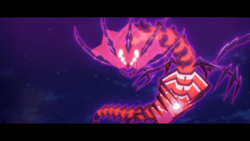


 For other sprites and images, please see Eternatus images on the Bulbagarden Archives.
For other sprites and images, please see Eternatus images on the Bulbagarden Archives.
